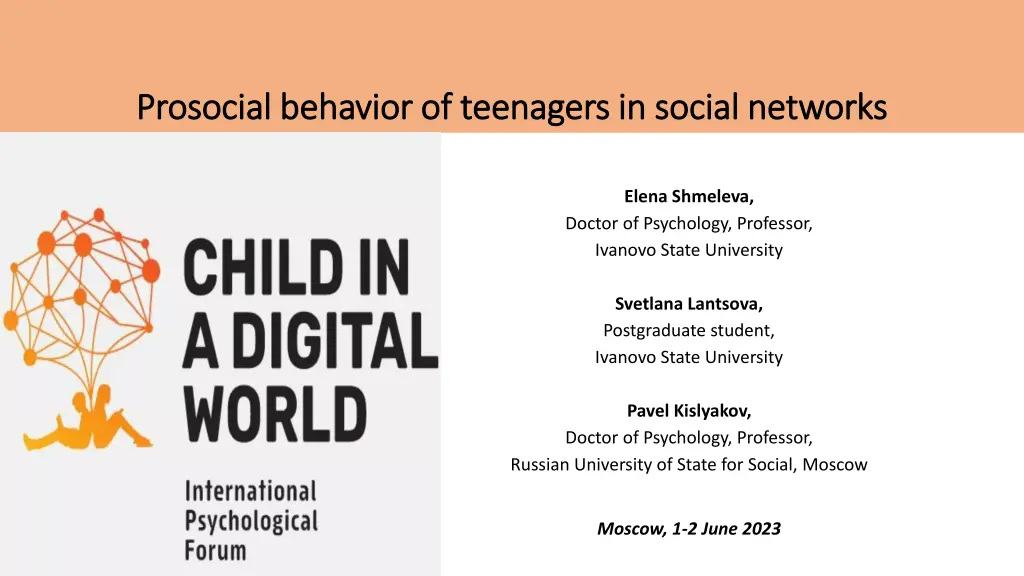
Prosocial Behavior of Teenagers in Social Networks Study
Explore the manifestations and importance of prosocial behavior among teenagers in social networks, including types of behaviors and benefits. The study conducted by Elena Shmeleva and team delves into the frequency and gender differences in performing and receiving prosocial behavior online, emphasizing the significance of positive online interactions for teenagers' well-being and development.
Download Presentation

Please find below an Image/Link to download the presentation.
The content on the website is provided AS IS for your information and personal use only. It may not be sold, licensed, or shared on other websites without obtaining consent from the author. If you encounter any issues during the download, it is possible that the publisher has removed the file from their server.
You are allowed to download the files provided on this website for personal or commercial use, subject to the condition that they are used lawfully. All files are the property of their respective owners.
The content on the website is provided AS IS for your information and personal use only. It may not be sold, licensed, or shared on other websites without obtaining consent from the author.
E N D
Presentation Transcript
Prosocial behavior of teenagers in social networks Prosocial behavior of teenagers in social networks Elena Shmeleva, Doctor of Psychology, Professor, Ivanovo State University Svetlana Lantsova, Postgraduate student, Ivanovo State University Pavel Kislyakov, Doctor of Psychology, Professor, Russian University of State for Social, Moscow Moscow, 1-2 June 2023
Prosocial behavior (PB) in social networks is a manifestation of digital socialization, which includes voluntary behavior in an online environment in order to benefit specific people or promote harmonious relationships with others (Erreygers et al, 2018)
Types of prosocial behavior in social networks: exchange of resources exchange of information emotional support online help liking a friend s post sending a nice message
Why pro-social behavior on social media is important? he benefits of prosocial behavior for teenagers: to establish a social norm of positive online interactions vs cyberaggression better academic successes (Gebrino et al, 2018) have better social connections (Jin et al, 2022) to increase social connectedness are more likely to succeed in adulthood (Toumbourou16) to improve relationship quality feel more satisfied and happy (Aknin, 2012; Son et Padilla-Walker, 2020) to foster adolescents well-being and self-esteem
Research methods The self-reporting methodology "Online behavior adolescents" (OPBS) Erreygers, scales performing receiving prosocial behavior online The purpose of the study: to evaluate the frequency and manifestations of prosocial experience of adolescents in social networks Selection 342 teenagers aged 12-19 (M=15.2) from secondary schools and colleges of the Ivanovo region took part in the survey prosocial of Research organization S. 2018,. of and
The main results 37 Frequency of PB online Gender difference 35.92 36 35 34.01 34 RECEIVE PB ONLINE 33 32.65 31.8 32 30.66 31 PERFORM PB ONLINE 34.25 30 29 EXPERIEN CE OF PB 34 28 perform PB online receive PB online 0 10 20 30 40 50 boys girls
The main results Types of prosocial behavior in social networks LET SOMEONE KNOW THAT YOU LIKE HIM/ HER 2.64 HELP SOMEONE WITH HIS/HER SCHOOL WORK 3.06 COMFORT/CONSOLE SOMEONE 3.4 LET KNOW THAT YOU LIKE SOMETHING (E.G., LIKE SOMETHING, SEND A SMILEY ) 3.41 COMPLIMENT OR CONGRATULATE SOMEONE 3.5 HELP SOMEONE OR OFFER TO HELP 3.5 SAY NICE/FRIENDLY THINGS ABOUT SOMEONE 3.56 SUPPORT SOMEONE 3.65 SAY NICE/FRIENDLY THINGS TO SOMEONE 3.71 CHEER UP SOMEONE 3.82 0 0.5 1 1.5 2 2.5 3 3.5 4 4.5
adolescents have experience of performing prosocial behavior on the Internet above average adolescents perform prosocial behavior online more often than they receive it in response teenage girls perform and receive prosocial behavior more often than teenage boys the most frequent type of prosocial behavior in social networks is emotional support for another and relationship support, the least frequent is an open display of sympathy and help with homework at school Summary the prosocial activity of adolescents in social networks, as well as in offline mode, is aimed at maintaining interpersonal relationships with peers and is less associated with assistance in educational activities
